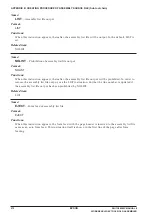
APPENDIX C ASSEMBLY TOOL REFERENCE <rel88>
286
EPSON
S5U1C88000C MANUAL II
WORKBENCH/DEV TOOLS/OLD ASSEMBLER
FLAGS
The rel88 can accept the following flags. The flags should be input with small letters.
Sorting of symbol names
Decimal output
Output of defined symbols
Output only global symbols
Standard input
Physical address and size of
multi-section
Sorting by symbol values
Sorts outputs in alphabetical order of the symbol names.
Outputs symbol values and segment sizes in decimal numbers.
The default is a hexadecimal number.
Outputs all defined symbols within each file, one per line. The symbol value, the
"relocation code" showing to what the value is related and the symbol name are entered
on each line. Values are output in the number of digits needed to indicate the integers in
the S1C88. The meanings of the relocation codes in the outputs are as follows.
• C indicates CODE relativity
• D indicates DATA relativity
• A indicates absolute (not relocatable)
• ? indicates rel88 cannot recognize it.
Small letters are used to indicate local symbols.
Capital letters are used for global symbols.
Outputs global symbols only.
Takes <files> from standard input and adds them to command line.
Redirecting is also possible and is valid when many files are specified.
Outputs the physical address and size of each section of multi-segment output files.
Sorts the inside of section by symbol values. The aforementioned -d flag is tacitly
specified. Symbols that have the same value are sorted in alphabetic order. Absolute
(non-relocatable) symbols are displayed first and are followed by CODE relative
symbols and DATA relative symbols.
Function
Explanation
Flag
-a
+dec
-d
-g
+in
+sec
-v
<files> are zero, or one or more files and they must have a multi-section format. When two or more
files are specified, the name of each file or module precedes the information that is output pertaining
to it. Each name is followed by a colon and a new-line. When there is no <files> specification, or when
a "-" appears on the command line, xeq is used as an input file.
ERROR MESSAGE
can't read binary header
can't read header
can't read symbol table
Reading of the object header excluding magic number and configuration
byte has failed.
Reading of the first two bytes of the object header (magic number and
configuration byte) has failed.
Reading of the symbolic table in the object has failed.
Error message
Description
RETURN VALUE
When a diagnostic message has not been created (in other words, when all the reads have succeeded
and all the file formats are valid), rel88 returns "success".






























